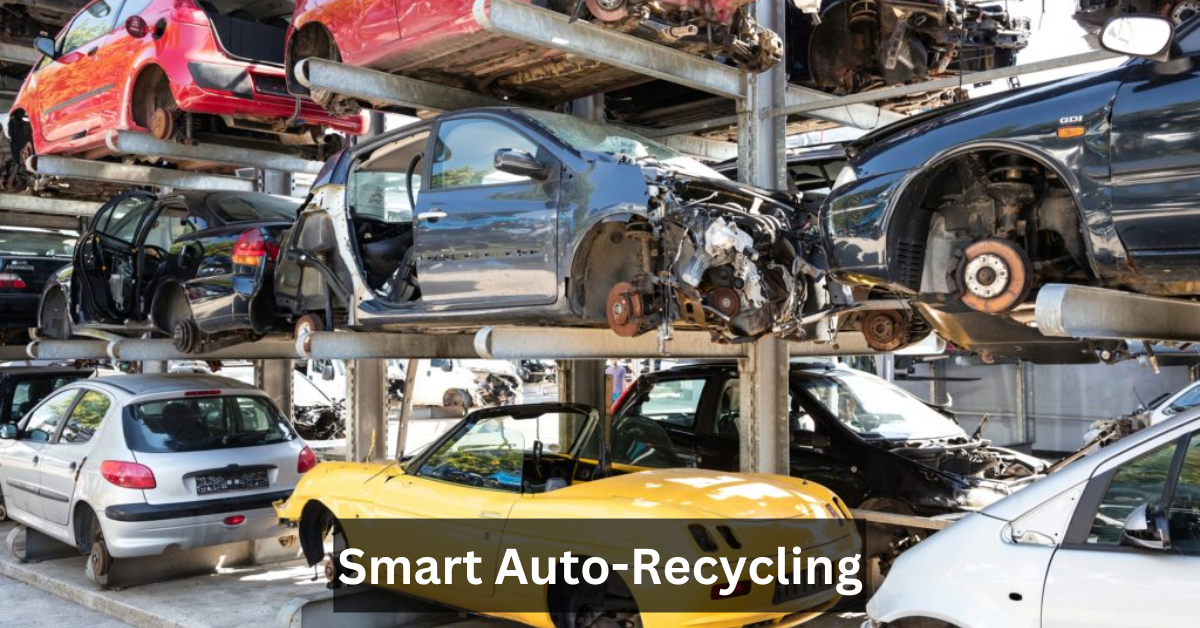Smart Auto-Recycling is a powerful blend of technology and sustainability, transforming how the automotive industry handles end-of-life vehicles. Instead of relying on outdated manual dismantling processes, this system uses Artificial Intelligence (AI), Internet of Things (IoT), robotics, and advanced analytics to maximize the value of recyclable car parts and reduce waste. In essence, Smart Auto-Recycling takes the old idea of a scrapyard and upgrades it with the intelligence and efficiency of modern automation.
With millions of cars reaching the end of their life every year, the traditional approach to vehicle disposal has become unsustainable. Smart Auto-Recycling isn’t just a trend—it’s a necessary innovation that aligns perfectly with today’s environmental goals and consumer expectations. From better part recovery to lower emissions, it offers a clear path toward a greener automotive ecosystem.
Traditional auto recycling processes involve a lot of manual labor, are often inconsistent, and leave room for environmental hazards and material loss. Scrap yards operating without smart systems can overlook reusable parts or fail to recover valuable resources like rare metals and EV batteries. As the industry shifts toward electric vehicles and digital integration, the shortcomings of outdated recycling methods have become more evident. Smart Auto-Recycling resolves this by introducing precision, traceability, and automation into every step of the process.
In many urban centers like Toronto, car recycling facilities are already seeing the need to upgrade and embrace intelligent vehicle recycling systems. The demand for cleaner, more efficient practices is not just coming from governments and regulators—it’s coming from environmentally aware consumers and sustainability-focused businesses.
How Smart Technologies Are Revolutionizing Auto Recycling
Artificial Intelligence (AI) in Vehicle Assessment and Part Sorting
AI plays a foundational role in Smart Auto-Recycling. By scanning vehicles and analyzing damage, it identifies which parts are salvageable and which are better off recycled. This intelligent analysis saves time, reduces waste, and ensures maximum profit from each vehicle processed. In practice, AI can outperform human inspectors in both speed and accuracy, making it a cornerstone of auto recycling technology.
Internet of Things (IoT) for Real-Time Data Monitoring
IoT-connected devices embedded within smart recycling facilities provide real-time updates on vehicle conditions, part inventory, and dismantling progress. These sensors help track everything from tire removal to battery extraction, minimizing error and improving compliance with environmental standards. In Smart Auto-Recycling systems, IoT enhances transparency and streamlines workflows.
Robotics in Automated Car Dismantling
Robotic arms and automation have brought an entirely new level of efficiency to automated car dismantling. These machines handle repetitive or dangerous tasks like fluid draining and airbag removal, greatly improving safety. With robotics, Smart Auto-Recycling eliminates guesswork and brings factory-level precision to the scrapyard floor.
Machine Learning for Demand Forecasting
Machine learning algorithms process data from car part sales, market trends, and regional demands to predict what parts are likely to be in demand. This predictive capability allows recyclers to focus their efforts on high-value components and reduce overstock. It’s one of the smartest ways to increase profits in a used car parts marketplace.
The Smart Auto-Recycling Process Explained
End-of-Life Vehicle (ELV) Diagnostics and Intake
The journey begins when a car reaches the end of its lifecycle and is brought to a smart recycling center. AI systems perform diagnostics to assess the condition and value of parts, while digital documentation logs everything in real-time. This improves efficiency and aligns with global compliance mandates such as the European End-of-Life Vehicles Directive (ELV).
Intelligent Dismantling and Sorting
Next, smart car recycling systems take over, dismantling the vehicle with robotic tools and sorting parts via machine vision. Usable items—like alternators, engines, and sensors—are tagged, labeled, and categorized for resale. Unusable components are safely processed for material recovery. This stage significantly enhances the vehicle dismantling process and contributes to eco-friendly car recycling.
Inventory Management and Component Tracking
Using blockchain or other advanced tech, Smart Auto-Recycling centers maintain a secure record of each part’s journey—from extraction to resale. This system reduces fraud and gives buyers confidence in the source and condition of their purchases. Toronto car recycling centers, for example, are starting to use these smart methods to support automotive sustainability goals.
Benefits of Smart Auto-Recycling
Environmental Advantages
Smart Auto-Recycling dramatically reduces landfill usage and ensures safer disposal of hazardous materials like EV batteries and motor oil. By focusing on green auto disposal and smart waste management, these systems support international efforts to fight climate change. Efficient part recovery also means fewer new parts need to be manufactured, reducing the industry’s overall carbon footprint.
Economic Gains for Businesses and Consumers
Recyclers benefit from increased revenue through better part recovery, and consumers get access to high-quality second-hand auto parts at competitive prices. Platforms like Car-Part.com and Copart have made it easier than ever to find and buy reliable recycled components—many of which are processed using Smart Auto-Recycling methods.
Improved Workplace Safety and Efficiency
Thanks to robotics and automation, scrapyard workers no longer need to perform dangerous manual tasks. This reduces injuries and improves job satisfaction. Additionally, the speed and accuracy of smart systems allow facilities to process more vehicles in less time.
Smart Auto-Recycling for Electric Vehicles (EVs)
Managing EV Battery Complexity
Electric vehicles come with unique recycling challenges, particularly their lithium-ion batteries. These components can be hazardous if mishandled. Smart Auto-Recycling uses AI and robotic tools to safely extract and process batteries, making the system ideal for EV battery recycling.
Material Recovery and Second Life Uses
Recovered EV parts are often refurbished and reused in secondary applications such as solar storage or grid stabilization. This not only extends the battery’s lifecycle but also aligns with circular economy in the auto industry principles.
Regulatory Compliance and Environmental Standards
Smart recycling systems ensure compliance with global regulations like the EPA, UNEP, and ISO 22628. As governments tighten restrictions on EV waste, Smart Auto-Recycling offers the safest and most compliant route forward.
Leading Companies and Innovators in Smart Auto-Recycling
Pioneering Brands and Platforms
Major players like LKQ Corporation, Copart, and Schnitzer Steel have embraced smart technologies to stay ahead of industry demands. Their systems use AI, big data, and blockchain to handle massive volumes with minimal environmental impact.
OEM Collaborations and Tesla’s Lead
Manufacturers like Toyota, Ford, GM, and Tesla are now designing vehicles with recyclability in mind. Tesla’s in-house recycling program is already a benchmark in the industry.
Tech Startups Driving Change
Smaller startups are contributing innovations like mobile smart dismantling units and AI-driven part matching systems. These agile companies are shaping the next evolution in auto salvage innovations.
The Role of AI, IoT, and Big Data
Predictive Analytics and Market Responsiveness
By using big data analytics, Smart Auto-Recycling centers can predict which vehicles to process based on regional trends, resale potential, and part demand.
Live Tracking and Smart Dashboards
IoT sensors and cloud systems let facilities monitor operations remotely, ensuring every step is traceable and efficient. These innovations make automotive waste tracking more precise than ever.
Digital Twins and Simulation-Based Planning
Digital twins simulate vehicle dismantling scenarios before execution, ensuring the safest, most cost-effective approach is always chosen.
Challenges in Adopting Smart Auto-Recycling
Cost Barriers for Small Businesses
Initial setup costs for robotics and smart systems can be steep. However, the long-term savings and ROI typically justify the investment, especially when scaled.
Training and Tech Literacy Gaps
A skilled workforce is essential. Without proper training, the potential of Smart Auto-Recycling can’t be fully realized. Programs to reskill workers are crucial for smooth adoption.
Data Privacy and System Security
As IoT devices generate more data, protecting that information becomes critical. Cybersecurity must evolve alongside smart technologies to prevent breaches.
Government Policies and Sustainability Standards
Organizations like the EPA, UNEP, and EU regulatory bodies are pushing automakers and recyclers to meet higher environmental standards. Policies such as the ELV Directive and Extended Producer Responsibility (EPR) make Smart Auto-Recycling not just beneficial—but mandatory.
Future Trends in Smart Auto-Recycling
Blockchain-Powered Transparency
Blockchain enables consumers and regulators to verify a part’s origin, recycling path, and condition with full transparency.
EV-Focused Facilities and Green Integration
New smart facilities are being built specifically for electric vehicles. These will integrate into smart cities and renewable grids to create seamless sustainable auto supply chains.
Consumer-Facing Marketplaces
As trust in smart systems grows, consumers will increasingly turn to digital marketplaces that offer certified recycled parts, further empowering the public to support sustainability.
Conclusion
Smart Auto-Recycling is not only changing how we dispose of vehicles—it’s redefining the entire lifecycle of the automobile. From the moment a car rolls off the assembly line to its final breakdown, intelligent systems now ensure every step is efficient, traceable, and eco-conscious. It is the backbone of future automotive sustainability and a vital part of global environmental health.
Frequently Asked Questions
Which vehicles benefit most from Smart Auto-Recycling?
End-of-life cars and electric vehicles (EVs) are especially suited due to their complex and valuable parts.
Is Smart Auto-Recycling expensive to implement?
The initial investment can be high, but long-term efficiency and resale value offer substantial returns.
How does Smart Auto-Recycling help consumers?
Consumers get affordable, reliable used parts from trusted sources with full transparency on part condition and origin.
What’s the biggest challenge facing Smart Auto-Recycling?
Adoption is limited by cost and lack of skilled personnel, especially in smaller or rural operations.
Stay in touch to get more updates & alerts on Erome! Thank you



